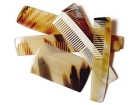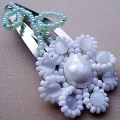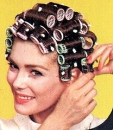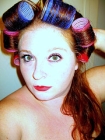Hair Styling Tools And Appliances

Combs:
It is better to used good quality combs with saw-cut teeth. Each individual tooth is cut into the comb, so there are no jagged or sharp edges which will damage your hair. Avoid cheap plastic combs that are made in mold as they damage the hair. They are sharp, and gradually scrape away the cuticle layers of the hair, causing damage and breakage of the hair. A wide-toothed comb is ideal for disentangling and combing conditioner through the hair. Fine tail-combs are for styling. Afro combs are specially designed for curly hair.

Pins And Clips:
These are essential for sectioning and holding hair during setting, and for holding the hair up. Most of the pins available are untipped with plain ends, or with cushioned-tipped ends. There are pins available that are not noticeable in the hair, and mostly are made out of metal, plastic or stainless steel. All colours are available.
i. Double-pronged grips: These are most frequently used for making pin or barrel curls. Grips give security to curls, pleats and all upswept styles. In North America they are known as “Bobby” pins, in Britain as “Kirbies”. To avoid discomfort, position grips in the hair so that the flat edge rests towards the scalp.
ii. Heavy hairpins: These are good for securing rollers in the hair and for putting the hair up. They are made of strong metal and are either waved or straight.
iii. Fine hairpins: These are used to pin up hair and are fine and delicate and prone to bend out of shape, so they should be used to secure small amounts of hair in place. If you can use a matching colour these pins can easily be concealed. They are sometimes used to secure pin curls during setting, instead of using the heavy clips which leave a mark.
v. Sectioning clips: These are clips with a single prong, and are longer in length than other clips. They are most often used for holding hair in place while working on another part, and also for securing pin curls.
vi. Twisted pins: Shaped like a screw, they are used to secure chignons and French pleats.

Rollers:
These styling tools vary in diameter, length and the material from which they are made. Smooth rollers, that is those without spikes or brushes, will give the sleekest finish, but they are more difficult to put in. More popular are brush rollers, especially the self-fixing variety that do not need pins or clips.
Roller Tips: The smaller the roller, the tighter the curl. Make sure you keep the tension even when winding. Try not to buckle the ends of the hair.

Shapers:
These soft styling devices were inspired by the principle of rag-rolling. Soft “twist tie” rollers are made from pliable rubber, plastic or cotton fabric and provide one of the more natural ways to curl hair. In the centre of each roller is a tempered wire, which enables it to be bent into shape. The waves or curls that are produced are soft and bouncy and the technique is gentle enough for permed or tinted hair. To use, section clean, dry hair and pull to a firm tension, “trapping” the end in a roller that you have previously doubled over. Roll down to the roots of the hair and fold over to secure. Leave it normally for about 30-60 minutes, without heat or if you apply heat, for 10-15 minutes. If the hair is twisted before curling, then a more voluminous style will be achieved. Heated styling appliance allow you to style your hair quickly, easily and efficiently. A wide range of heated appliances is available.